I still remember the first time I tasted authentic Tuscan chicken at a tiny trattoria tucked away in the hills of Chianti. The owner, Nonna Maria, watched me take that first bite with knowing eyes. She’d seen that exact expression countless times—pure culinary revelation washing over someone’s face.
That dish changed everything I thought I knew about Italian cooking. It wasn’t just about the ingredients; it was about the soul poured into every step.
Tuscan chicken, or Pollo alla Toscana, represents the very essence of Tuscan cuisine—rustic simplicity elevated to extraordinary heights. This isn’t your typical weeknight chicken dinner. It’s a celebration of sun-drenched tomatoes, aromatic herbs, and time-honored techniques that have been passed down through generations of Italian nonnas.
What makes this recipe truly special lies in its deceptive simplicity. Every element serves a purpose, from the initial searing that creates those coveted caramelized edges to the slow braising that transforms tough connective tissues into silky, flavor-packed goodness. The magic happens when earthy rosemary meets sweet San Marzano tomatoes, creating a sauce so complex you’d swear it took hours of preparation.
Understanding the Foundation: Ingredients That Matter
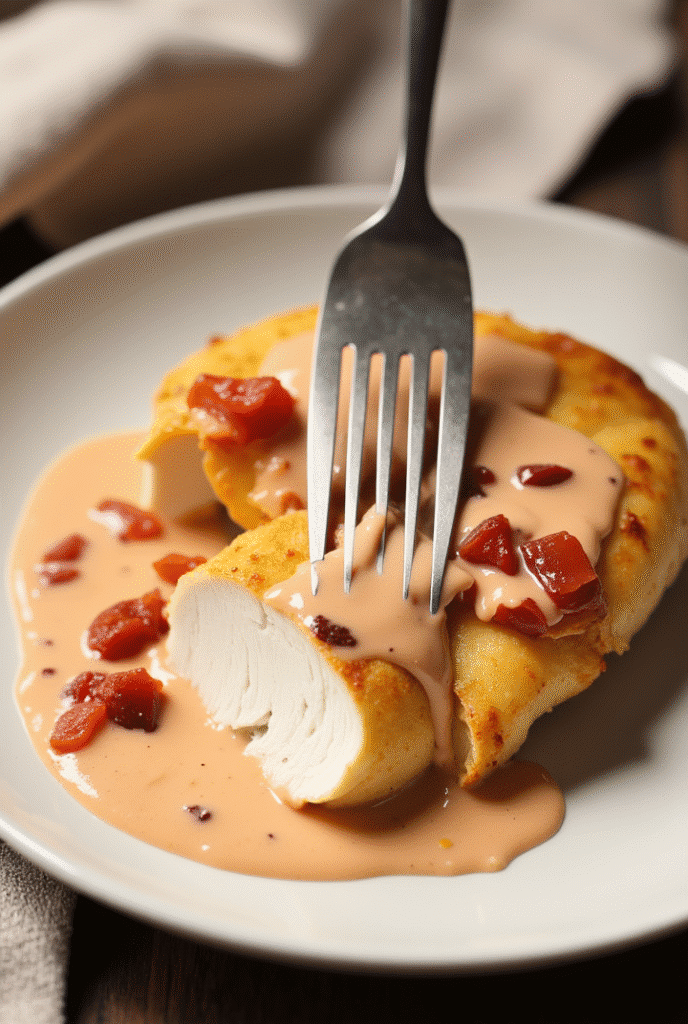
The Chicken Selection
Your choice of chicken can make or break this dish. I always recommend bone-in, skin-on thighs for their superior flavor and moisture retention. The bones release collagen during cooking, creating that restaurant-quality body in your sauce. Dark meat handles the extended cooking time beautifully, unlike breast meat which tends to dry out and become stringy.
If you’re committed to white meat, bone-in breasts work better than boneless. The cooking time will need adjustment—roughly 25-30 minutes instead of the traditional 35-40 for thighs. For those avoiding skin, you’ll lose some richness, but the dish remains delicious.
Tomato Selection: The Heart of Tuscany
San Marzano tomatoes aren’t just marketing hype—their naturally low acidity and sweet flavor profile creates the perfect base for this sauce. The volcanic soil of Mount Vesuvius imparts a unique mineral complexity that’s impossible to replicate. When fresh San Marzanos aren’t available, high-quality canned versions work wonderfully. Avoid generic crushed tomatoes; they often contain added sugar and lack the depth needed for authentic flavor.
Fresh tomatoes work during peak season, but they require different handling. Remove the skins by scoring an X on the bottom, blanching in boiling water for 30 seconds, then shocking in ice water. The skins will slip right off.
Herbs and Aromatics: Building Flavor Layers
Fresh rosemary is non-negotiable in authentic Tuscan chicken. The woody, piney notes complement the richness of the meat while cutting through the sauce’s acidity. Strip the leaves from the stems and chop them finely—whole sprigs can overwhelm delicate palates. Dried rosemary works in a pinch, but use half the amount and crush it between your fingers to release the oils.
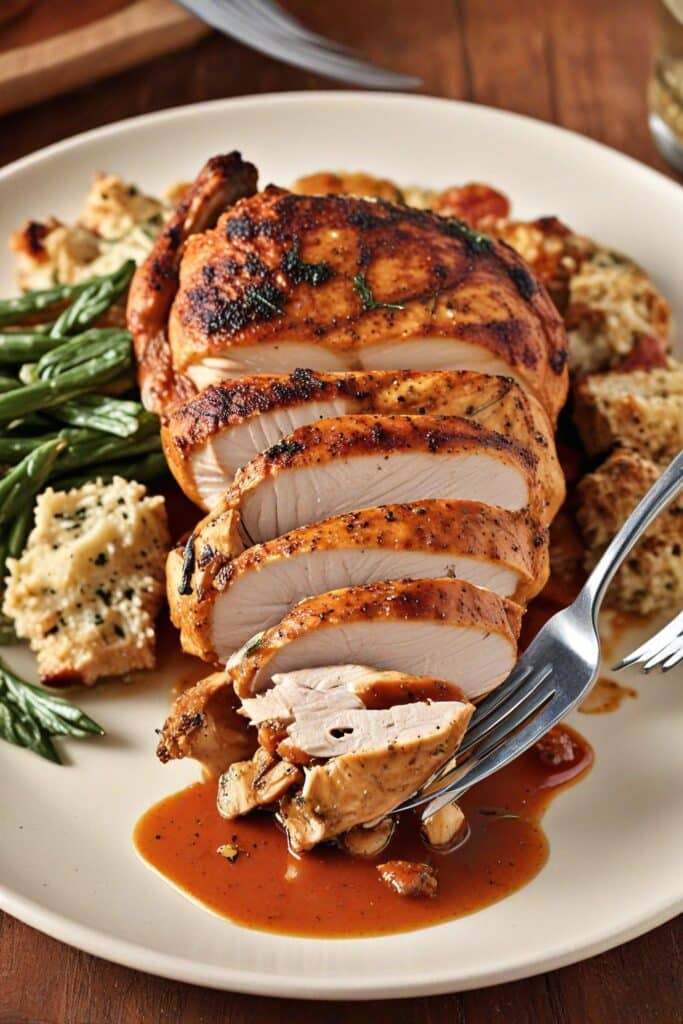
Garlic should be sliced thin, not minced. This technique, preferred by Italian cooks, allows the garlic to infuse the oil without burning and becoming bitter. Six cloves might seem excessive, but they mellow considerably during the long cooking process.
Fresh thyme adds subtle earthiness that pairs beautifully with rosemary. If unavailable, oregano provides a acceptable substitute, though the flavor profile shifts slightly more Mediterranean.
Wine Selection: Cooking Liquid Gold
The wine you choose becomes concentrated during cooking, so quality matters immensely. A crisp Pinot Grigio or Vernaccia di San Gimignano captures the Tuscan terroir perfectly. The acidity helps tenderize the meat while adding brightness to balance the rich tomatoes.
Never cook with wine you wouldn’t drink—off flavors become magnified during reduction. If avoiding alcohol, substitute with high-quality chicken stock mixed with a tablespoon of white wine vinegar for acidity.
Oil and Finishing Touches
Extra virgin olive oil should be your only choice here. The grassy, peppery notes of good Tuscan oil complement the other flavors beautifully. Use a lighter oil for cooking and reserve your best bottle for finishing—a drizzle just before serving adds incredible depth.
Parmigiano-Reggiano cheese isn’t traditional in every version, but a light grating adds umami richness that elevates the entire dish. Choose aged varieties (24+ months) for maximum flavor impact.
Mastering the Technique: Step-by-Step Excellence
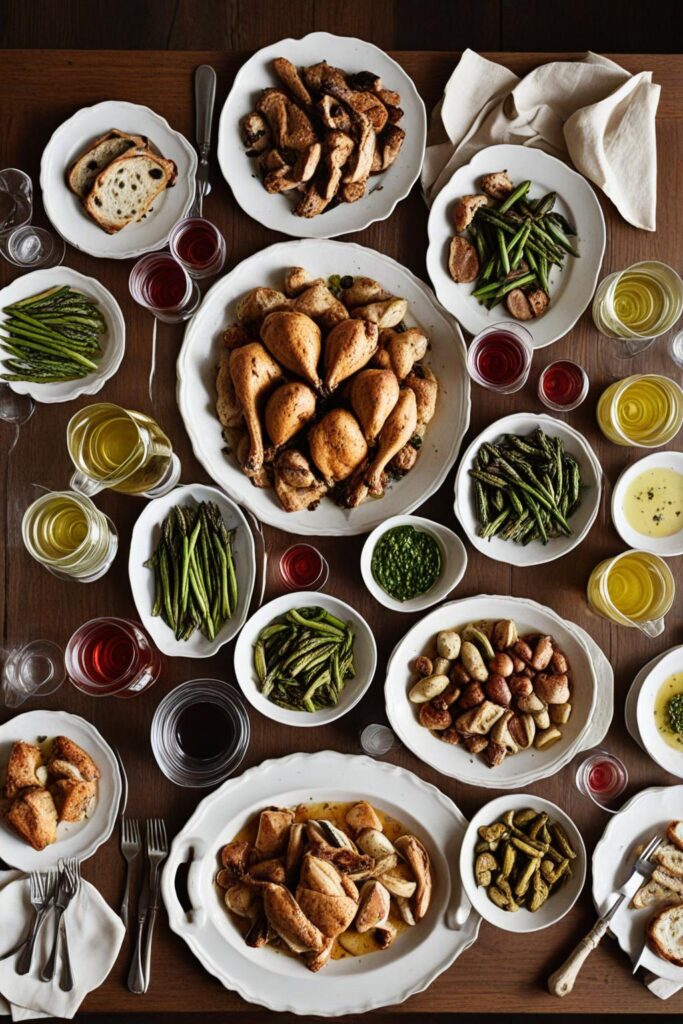
Preparation and Mise en Place
Professional kitchens succeed because of proper preparation. Pat your chicken completely dry with paper towels—this step is crucial for proper browning. Moisture is the enemy of caramelization. Season generously with kosher salt and freshly cracked black pepper at least 30 minutes before cooking. This allows the seasoning to penetrate the meat properly.
Room temperature chicken cooks more evenly than cold. Remove it from the refrigerator 45 minutes before cooking begins. This prevents the dreaded scenario where the outside overcooks while the inside remains underdone.
The Critical Searing Phase
Heat your heavy-bottomed Dutch oven or braising pan over medium-high heat until it’s properly hot—you should feel the heat radiating when you hold your hand six inches above the surface. Add just enough olive oil to coat the bottom; too much oil prevents proper browning.
Place chicken pieces skin-side down without overcrowding. The sizzle should be immediate and aggressive. Resist the urge to move the pieces—proper browning takes 4-5 minutes per side. The skin should release easily when it’s ready; if it sticks, it needs more time.
This browning phase, known as the Maillard reaction, creates hundreds of new flavor compounds that form the dish’s foundation. Those caramelized bits stuck to the pan (called fond) will be deglazed later, adding incredible depth to your sauce.
Building the Aromatic Base
Remove the chicken and set aside—it’s not fully cooked yet, which is exactly what we want. Reduce heat to medium and add your sliced garlic to the rendered fat. The key here is gentle cooking; burned garlic ruins the entire dish. Cook until fragrant and just beginning to color, roughly 60-90 seconds.
Add the chopped rosemary and thyme next. The herbs should sizzle gently, releasing their essential oils into the fat. This process, called blooming, intensifies their flavors dramatically compared to adding them later.
Deglazing and Sauce Development
Pour in your white wine and scrape up all those beautiful browned bits from the bottom of the pan. This process, called deglazing, incorporates all the flavor development from the searing phase. The wine should bubble vigorously initially, then settle into a gentle simmer.
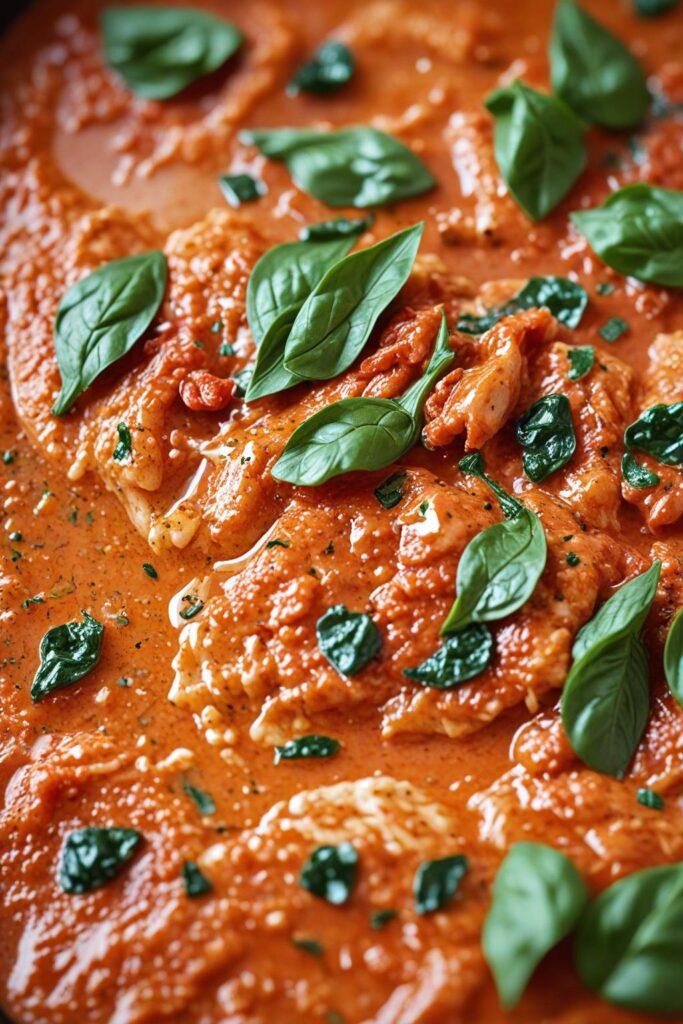
Let the wine reduce by half—this concentrates the flavors and cooks off the harsh alcohol notes. You’ll know it’s ready when you can no longer smell the sharp alcohol aroma.
Add your tomatoes now, crushing them gently with your hands as they go into the pan. Hand-crushing creates better texture than pre-crushed varieties, with some larger pieces providing interesting textural contrast. Season with salt and a pinch of sugar if your tomatoes seem particularly acidic.
The Braising Process
Return the chicken to the pan, nestling it skin-side up into the sauce. The liquid shouldn’t completely cover the pieces—we want the skin to remain above the surface and stay crispy. If needed, add a splash of chicken stock to reach the proper level.
Bring the mixture to a gentle simmer, then transfer to a 350°F oven. The steady, even heat of the oven provides better results than stovetop cooking, which can create hot spots and uneven cooking.
Cooking time varies depending on your chicken size, but plan for 35-40 minutes for thighs or 25-30 for breasts. The meat should be fork-tender and pulling away from the bones. Internal temperature should reach 165°F, but texture is more important than temperature for this dish.
The Science Behind the Magic
Understanding why this technique works elevates your cooking from following recipes to true culinary understanding. The initial searing creates the Maillard reaction, forming complex flavor compounds that can’t be achieved through other cooking methods. These reactions only occur at high temperatures with dry heat—hence the importance of patting the chicken dry.
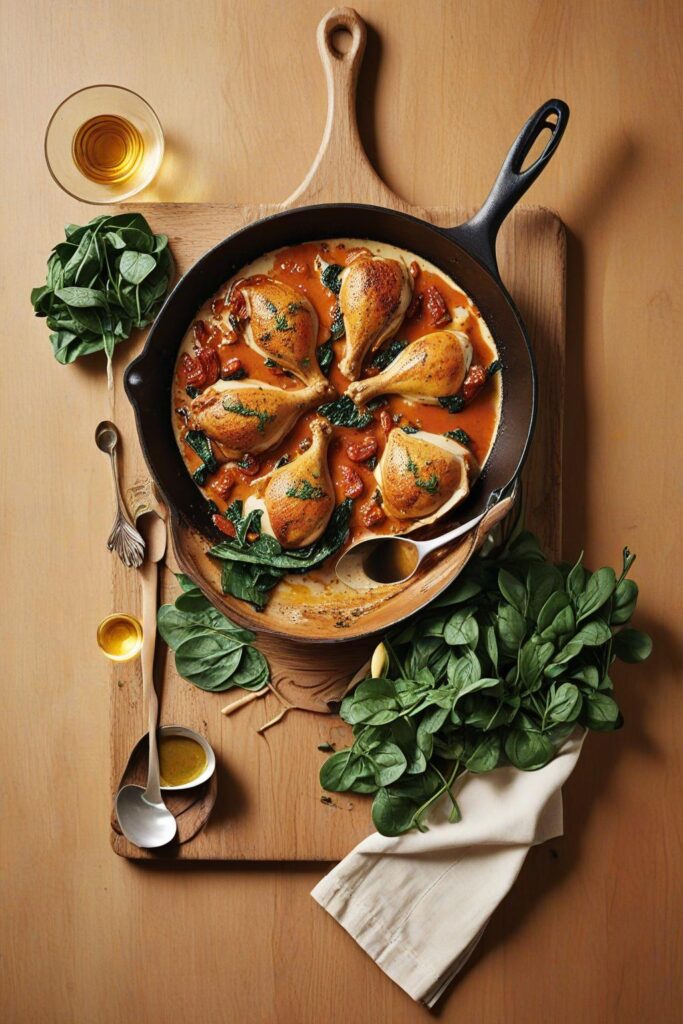
The braising liquid serves multiple purposes beyond simple cooking medium. The acidity from tomatoes and wine helps break down tough collagen in the meat, converting it to gelatin. This process creates the silky mouthfeel that distinguishes restaurant-quality braises from home cooking attempts.
The herbs release different compounds at different temperatures. Rosemary’s woody terpenes are heat-stable and actually improve with longer cooking, while thyme’s more delicate compounds are preserved by the relatively low braising temperature.
Wine’s role extends beyond flavor—the alcohol acts as a solvent, extracting flavor compounds from the other ingredients that water alone cannot. Even after cooking, trace amounts remain, contributing to the sauce’s complexity.
Serving and Presentation Excellence
Traditional Tuscan presentation is rustic yet elegant. Serve directly from the cooking vessel when possible—cast iron or enameled Dutch ovens make beautiful serving pieces. The communal aspect of sharing from one pot reflects Italian dining culture perfectly.
Garnish simply with fresh rosemary sprigs and a drizzle of your best olive oil. The oil’s peppery bite provides a perfect counterpoint to the rich sauce. A light dusting of Parmigiano-Reggiano adds visual appeal and umami depth.
Perfect Pairings
Creamy polenta is the traditional accompaniment, its smooth texture contrasting beautifully with the chicken’s crispy skin. Risotto works wonderfully too, particularly versions made with Carnaroli rice for superior texture.
For wine pairings, stay within Tuscany’s borders. Chianti Classico’s bright acidity and moderate tannins complement the dish perfectly. Brunello di Montalcino offers more structure for special occasions, while Vernaccia provides a crisp white alternative.
Rustic bread is essential for sopping up every drop of sauce. Tuscan bread’s saltless tradition actually works perfectly here—it won’t compete with the dish’s carefully balanced flavors.
Seasonal Variations
Spring versions benefit from fresh peas and baby artichokes added during the last 10 minutes of cooking. Summer calls for fresh basil stirred in just before serving. Fall preparations can include roasted chestnuts or wild mushrooms. Winter versions shine with the addition of cannellini beans for heartiness.
Troubleshooting Common Issues
Sauce Too Thin
Reduce the sauce on the stovetop after removing the chicken. High heat and frequent stirring concentrate flavors quickly. Alternatively, mix a tablespoon of tomato paste with a splash of cooking liquid and stir into the sauce.
Chicken Overcooked
This usually results from using boneless cuts or cooking at too high temperature. Next time, choose bone-in pieces and verify your oven temperature with a separate thermometer—many ovens run hot.
Lack of Flavor Depth
This often indicates insufficient browning during the searing phase or using low-quality ingredients. Don’t rush the initial browning, and invest in good tomatoes and wine.
The Cultural Context
This dish embodies everything beautiful about Tuscan cooking philosophy. It transforms humble ingredients into something extraordinary through technique and patience. The recipe varies from village to village, family to family—there’s no single “correct” version.
What remains constant is the respect for ingredients and the understanding that great cooking requires time. In our rush-everything culture, dishes like this remind us that some things simply cannot be hurried.
The communal aspect matters too. Tuscan meals are social events, and this dish practically demands sharing. The aroma alone draws people to the kitchen, creating connections over shared appreciation for real food prepared with care.
Frequently Asked Questions
Can I make this dish ahead of time?
Absolutely—in fact, it improves after a day in the refrigerator. The flavors meld and deepen beautifully. Reheat gently on the stovetop, adding a splash of wine or stock if needed to loosen the sauce. The chicken skin won’t be quite as crispy, but the overall flavor will be even better.
What’s the best way to store leftovers?
Store in the refrigerator for up to four days in an airtight container. The sauce tends to thicken when cold, so add liquid when reheating. Freezing works for up to three months, though the texture changes slightly—the sauce may separate but can be whisked back together.
Can I use boneless chicken for this recipe?
While possible, you’ll sacrifice significant flavor and texture. Boneless thighs work better than breasts, but reduce cooking time to 20-25 minutes. The sauce won’t have the same body without bones releasing collagen during cooking.
My sauce is too acidic—how do I fix it?
Add a pinch of sugar or a splash of cream to balance the acidity. This often happens with certain tomato varieties or when wine doesn’t reduce sufficiently. Taste and adjust gradually—you can always add more but can’t take it back.
What’s the difference between this and Chicken Cacciatore?
While similar in technique, Tuscan chicken focuses on tomatoes, herbs, and wine, while Cacciatore (hunter’s style) traditionally includes mushrooms, bell peppers, and sometimes olives. The flavor profiles are distinct, with Tuscan versions being more refined and less rustic than their hunter-style cousins.
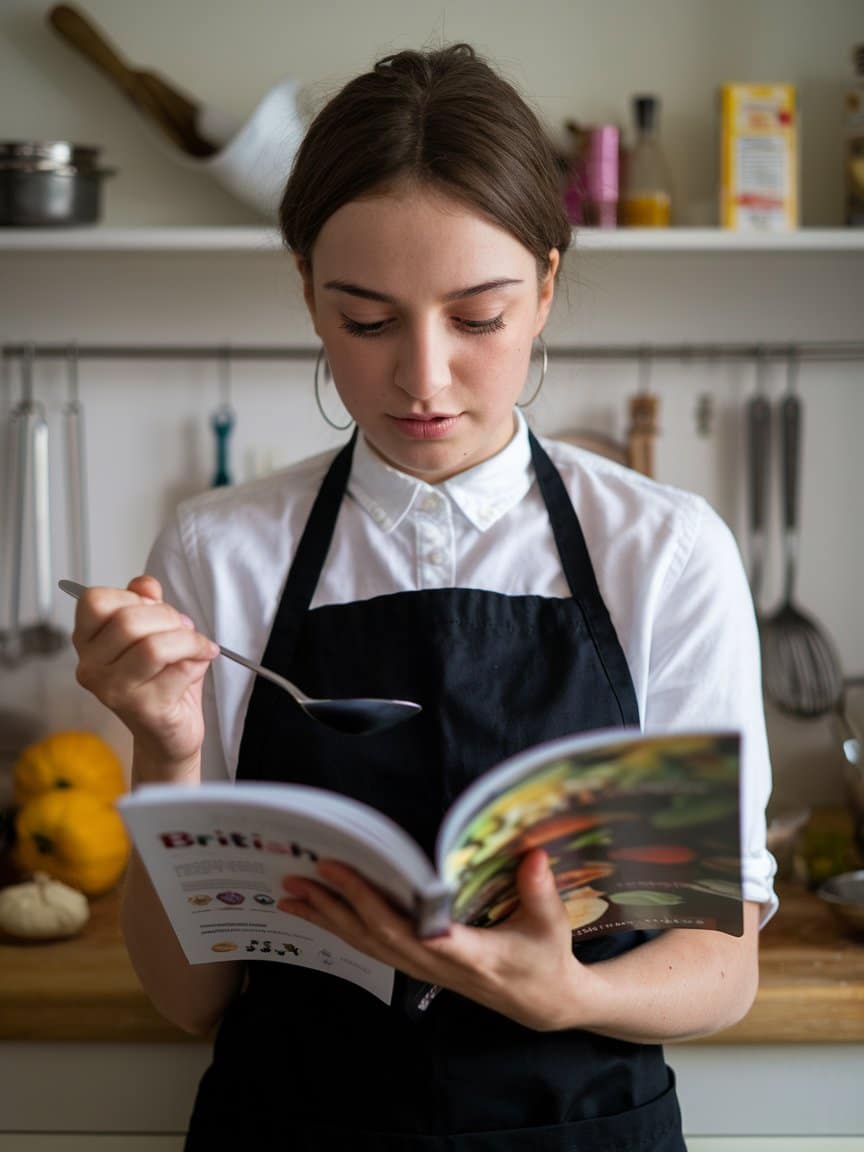
Veronica is a passionate food enthusiast with over three years of experience in exploring and writing about diverse cuisines. Her expertise lies in reviewing restaurants, sharing creative recipes, and discovering the latest food trends. As the voice behind FoodieRecap.com, Anju brings fresh perspectives and culinary insights to her audience.
